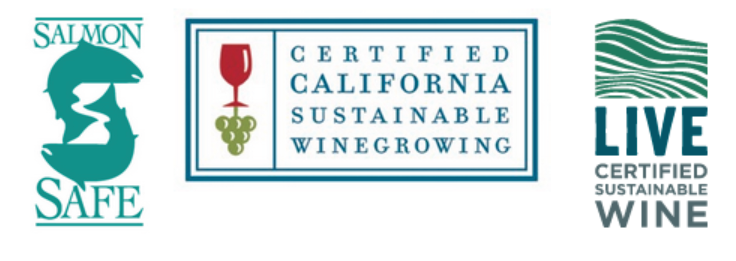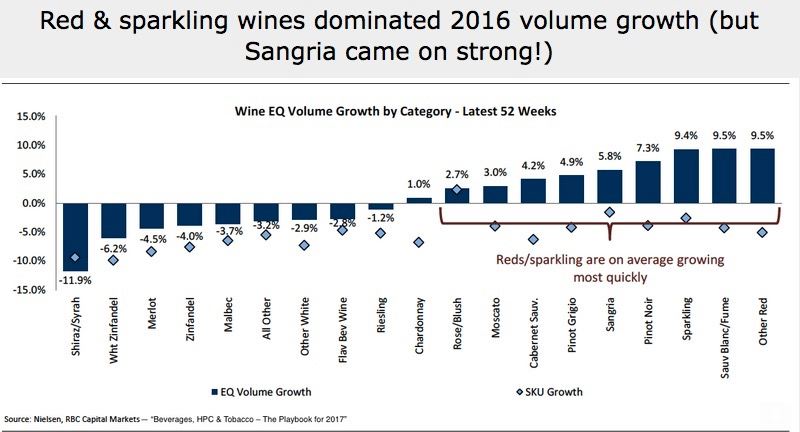Pinot Noir Trends & Topics Looking Back at 2016
Looking back at 2016, I observed a number of trends and noteworthy topics reflecting the evolving domestic
Pinot Noir world.
(1) There has been a noticeable reduction in the number of previously popular Pinot Noir centric celebrations.
Pinot Days has had events in Los Angeles, San Francisco and Chicago but is now reduced to a single
event in San Francisco. Pinot Paradise in the Santa Cruz Mountains was an annual affair with as many
as 900 people attending, but is no longer held. West Sonoma County Vintners’ West of West Festival
had their last event in San Francisco in May 2016. In Pursuit of Balance held their last event in 2016
and disbanded. Pinot Family Reunion in Santa Rosa was last celebrated in 2014. Pasadena Grand
PinotFest has not had an announced event since 2014. Affairs of the Vine annual Pinot Shootout was
last held in 2015. The future of the Marin County Wine Celebration (formerly the Marin County Pinot
Noir Celebration) is in jeopardy in 2017. Many of the Pinot Noir events that have soldiered on have
gotten more expensive to attend and mainly attract the well-healed, baby-boomer consumer. The
events have had to budget significantly less for media and press attendance resulting in feeble publicity.
Winemakers have found that the large walk-around tasting events result in little post-event sales and
have looked elsewhere to invest their marketing dollars. Wine critics do not find these venues to be
ideal for serious wine evaluation.
2017 Domestic Pinot Noir Festivals
World of Pinot Noir Bacara Resort & Spa, Santa Barbara, CA, March 3-4, www.wopn.com
Pigs & Pinot Healdsburg, CA, March 17-18, www.pigsandpinot.com
Anderson Valley Pinot Noir Festival Anderson Valley, CA, May 19-21, www.avwines.com
Santa Lucia Highlands (SLH) Gala Mer Soleil Winery, CA, May 20, www.santaluciahighlands.com
Paso Pinot & Paella Festival Templeton, CA, June 4, www.pinbotandpaella.com
Marin County Wine Celebration June
Pinot, Pigs & Poetry Omaha, NB, June 1, www.pinotandpigs.org
International Pinot Noir Celebration (IPNC) McMinnville, OR, July 28-30, www.ipnc.org
Wine & Fire Sta. Rita Hills, CA, August date to be announced, www.staritahills.com
Winesong! Mendocino, CA, September 8-9, www.winesong.org
Pinot on River Healdsburg, CA, October date to be announced, www.pinotfestival.com
Big Sur Food & Wine Festival Big Sur, CA, November 2-4, www.bigsurfoodandwine.org
PinotFest Farallon Restaurant, San Francisco, CA, mid-November date to be announced, www.farallonrestaurant.com
¡Salud! Oregon Wine Auction, Willamette Valley and Portland, OR, November date to be announced, www.saludauction.com
(2) The term “Burgundian style” has been over used in winery promotional material, winery websites and back labels.
This naive term is laughable because it is nebulous and has no definite meaning. It is used to imply a
wine of better quality, since many consumers consider Burgundy to be the reference wine for Pinot Noir.
(3) Pinot Noir rosé and rosé wines in general have enjoyed a surprising rise in popularity of late, but have you
ever had a rosé wine that you swooned over or elicited emotion like regular Pinot Noir? Many domestic wineries produce a few hundred cases each year to satisfy the rosé seekers, but at its average price of
around $18, rosé is a money losing proposition for wineries and very few produce it with serious intent.
(4) I have been frustrated by writing about incredibly great Pinot Noir wines that most people can’t afford and
and will never experience. Prices for high-end domestic Pinot Noir have been escalating since the 2009
recession recovery. I think many wine drinkers never sample an exceptional Pinot Noir and wonder
what the big deal is about Pinot Noir. The average price of the 2016 California Pinot Noir All-
Americans was $70. Nine of the All-Americans were priced $100 or more (about 12% of the wines).
(5) Wines continue to be rushed to market by many wineries and reviews of these wines may occur shortly
after bottling before the wines have recovered from bottle shock. Ideally, bottled wines should be
reviewed initially at least 6 months after bottling.
(6) The American palate has little experience with aged Pinot Noir. Most wine purchased is consumed shortly
thereafter. There are practically no restaurants that offer any significant number of aged domestic Pinot
Noirs on their wine lists. Wineries rarely hold back a library of wines for later release since it makes little
business sense.
(7) A number of wineries that previously had tasting rooms open daily are now catering to consumers through
an appointment only model. Examples are Lynmar, Arista and Gary Farrell in the Russian River Valley.
This weeds out the social drinkers who purchase little wine and allows the winery to focus their attention
on serious wine drinkers who relish the personal attention and purchase more wine.
(8) Inbox overload. Everyone receives too many emails, much of it unwanted or unsolicited. Wineries try to
engage customers through frequent email information and offers but this tactic is ineffective
because people are deluged with email advertising. In time they often unsubscribe.
(9) Proliferation of second labels and retailer-specific labels continues. There are so many new Pinot Noir
labels, I cannot keep up. Many premium Pinot Noir producers bottle inexpensive versions of their wine
under a second label. Large wine retailers like Total Wine & More, BevMo! and Trader Joe’s have
multiple discounted and exclusive Pinot Noir bottlings that are unremarkable. There is no way to trace
where these wines were actually produced or who the winemaker was.
(10) There is a continued heightened superiority of Sonoma Coast Pinot Noir over other wine regions of
California. 40% of my 2016 California All-Americans had a Sonoma Coast AVA designation.
(11) Curse of the wax closure continues. Wax closures are eye candy, but they are a pain in the ass when
opening a bottle of Pinot Noir. Fragments of wax invariably find their way into the wine. Don’t even think
about bringing a wax-closed bottle to a restaurant. Let’s outlaw them!
(12) Cork taint continues in a small percentage of Pinot Noir and Chardonnay I opened this past year. I would
say it is less than 3% although there are some bottles that I suspect are corked but cannot be sure
since the taint is subtle and undetectable by my senses. Wineries that use screwcap closures continue
to do so but I see almost no new winery conversions to this type of closure.
(13) Sustainability is important but poorly understood by the consumer. It is defined as growing and
winemaking practices that are sensitive to the environment, responsive to the needs and interests of
society-at-large, and are economically feasible to implement and maintain. The Sonoma Winegrowers
website states, “Sustainability is complex, but the results are simple - the land stays preserved in
agriculture, people are trained, save and treated with respect and the business endures.” Several
regional sustainable farming certification programs for wine grapes have been established. Sonoma
County has committed to becoming the first 100% sustainable wine region in the nation by 2019.
However, many wineries claim sustainable practices are used to grow grapes and in the winery yet they
have no basis of verification unless they belong to one of these certification programs. In addition,
there is no clarity in the definition and scope for the sustainability concept and the certification programs
are not necessarily comparable. Organizations in California include Certified California Sustainable
Winegrowing (CCSW), Sustainability in Practice (SIP), Salmon-Safe and Napa Green, and in Oregon,
Low Input Viticulture and Enology (LIVE), Oregon Tilth, and Salmon-Safe. Look for the logos of these
programs on the back labels of wine bottles as proof of certification.

(14) I had the idea that it would be interesting to compare scores of Pinot Noir wines I reviewed in 2016 to
reviews found in The Wine Advocate, Wine Spectator, Wine Enthusiast and Wine & Spirits. It turned
out that I could find very few of the same wines reviewed by all five of these sources. Also, the project
seemed to involve a complicated comparison since some of the other review sources do not have one
individual doing all the Pinot Noir reviews. For example, domestic Oregon Pinot Noir is reviewed by
Neal Martin, Central California Pinot Noir by Jeb Dunnick and Northern California Pinot Noir by Robert
Parker in The Wine Advocate. Parker’s tastings are usually in peer-group, single-blind conditions with
some exceptions. Wine & Spirits has a screening panel consisting of retailers, sommeliers,
winemakers and other wine professionals who send qualifying wines that are then blind tasted, rated
and described by one critic (who is not named). For Wine Spectator reviews, James Laube is the
California Pinot Noir critic and Harvey Steiman is the Oregon Pinot Noir critic. The wines are tasted
blind with the taster’s initials at the end of the tasting note (reviews without initials at the end of the
tasting note were reviewed by two or more tasters). Wine Enthusiast employs Matt Kettmann, Virginie
Boone, and Jim Gordon for California and Paul Gregutt for Oregon (the reviewer’s initials are included
in the review), although none of these reviewers concentrate solely on Pinot Noir. Wines are tasted in
peer-group flights blind. Another major wine review website is Antonio Galloni Vinous that acquired
Stephen Tanzer’s International Wine Cellar (IWC) in November 2014. Antonio Galloni covers Napa
Valley, Sonoma, Santa Barbara, and Santa Cruz Mountains, and Josh Raynolds covers Oregon and the
Santa Lucia Highlands. Vinous and IWC reviews are available on CellarTracker. None of these critics
solely cover Pinot Noir. The method of tasting is not described on the Vinous website. Allen Meadows of
Allen Meadows’ Burghound.com is the sole reviewer for California and Oregon Pinot Noir. I am not sure
if tasting of domestic Pinot Noir is blind.
(15) Whole cluster fermentation is a gamble, but when it pays off, the resultant Pinot Noir wines have more
interesting nuances, more seductive aromatics, more textural interest and probably more age ability. As
Laetitia winemaker Eric Hickey notes, “The hallmark of whole cluster wines is a signature burnt tobacco
note entwined with fruit aromas and flavors. There is an extra layer of structure to whole cluster Pinot
Noir. Whole cluster fermentation usually appeals to those who prefer a Pinot Noir with more structure
and less pure red fruit on the nose.” Many winemakers in in recent years have moved away from fruity
Pinot Noir by fermenting at least some percentage of whole clusters to impart complexity, tannic grip
and savory elements on the palate. Personally, many of the greatest domestic Pinot Noirs I have
encountered have had some whole cluster inclusion.
(16) Baby boomers still buy most of the wine in the U.S. according to SVB 2017 State of the Industry Report.
(17) Red and sparkling wines showed most volume growth in sales over the past year with Pinot Noir the
fourth highest growth.

(18) The decline of wine writing as a viable occupation continues. Jamie Goode published a post on his blog in
December titled, “The ill-health of wine writing.” He pointed out that there are very few wine writers who
make a living solely on writing. He noted, “The big problem is the continued flight of advertising money
away from professionally generated content (newspapers, magazines) onto platforms where the
content is user generated (Facebook, Twitter, etc). There’s no money left to pay writers.” Jeremy
Parzen, Adjunct Professor for Master in Food Culture & Communications at University of
Gastronomic Sciences in Italy expanded the discussion in January 2017. He points out, “Even at
the peak of interest in wine writing in the late 1990s and 2000s (up until the financial crisis of
2007-2008), there were very few people who made a real wage through writing about wine.....Aside
from a handful of full-time wine writers who still have positions with high-profile mastheads, I know
very few people who make a living exclusively by creating editorial content about wine.”